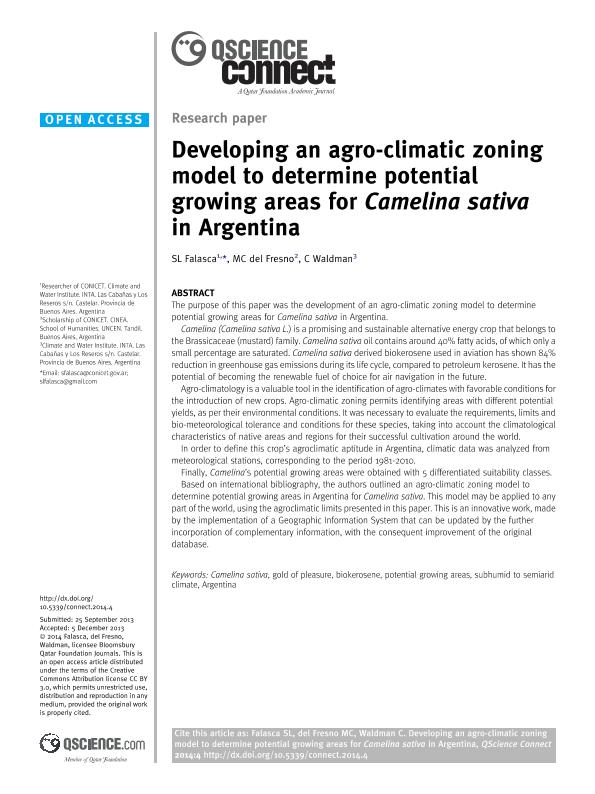Mostrar el registro sencillo del ítem
dc.contributor.author
Falasca, Silvia Liliana

dc.contributor.author
Miranda del Fresno, Ma. Carolina

dc.contributor.author
Waldman, C.
dc.date.available
2018-01-18T18:34:12Z
dc.date.issued
2014-01
dc.identifier.citation
Falasca, Silvia Liliana; Miranda del Fresno, Ma. Carolina; Waldman, C.; Developing an agro-climatic zoning model to determine potential growing areas for Camelina sativa in Argentina; Hamad bin Khalifa University Press; QScience Connect; 2014; 1; 1-2014; 1-11
dc.identifier.issn
2223-506X
dc.identifier.uri
http://hdl.handle.net/11336/33829
dc.description.abstract
The purpose of this paper was the development of an agro-climatic zoning model to determine potential growing areas for Camelina sativa in Argentina. Camelina (Camelina sativa L.) is a promising and sustainable alternative energy crop that belongs to the Brassicaceae (mustard) family. Camelina sativa oil contains around 40% fatty acids, of which only a small percentage are saturated. Camelina sativa derived biokerosene used in aviation has shown 84% reduction in greenhouse gas emissions during its life cycle, compared to petroleum kerosene. It has the potential of becoming the renewable fuel of choice for air navigation in the future. Agro-climatology is a valuable tool in the identification of agro-climates with favorable conditions for the introduction of new crops. Agro-climatic zoning permits identifying areas with different potential yields, as per their environmental conditions. It was necessary to evaluate the requirements, limits and bio-meteorological tolerance and conditions for these species, taking into account the climatological characteristics of native areas and regions for their successful cultivation around the world. In order to define this crop's agroclimatic aptitude in Argentina, climatic data was analyzed from meteorological stations, corresponding to the period 1981-2010. Finally, Camelina's potential growing areas were obtained with 5 differentiated suitability classes. Based on international bibliography, the authors outlined an agro-climatic zoning model to determine potential growing areas in Argentina for Camelina sativa. This model may be applied to any part of the world, using the agroclimatic limits presented in this paper. This is an innovative work, made by the implementation of a Geographic Information System that can be updated by the further incorporation of complementary information, with the consequent improvement of the original database.
dc.format
application/pdf
dc.language.iso
eng
dc.publisher
Hamad bin Khalifa University Press
dc.rights
info:eu-repo/semantics/openAccess
dc.rights.uri
https://creativecommons.org/licenses/by-nc-sa/2.5/ar/
dc.subject
Camelina Sativa
dc.subject
Gold of Pleausure
dc.subject
Biokerosene
dc.subject
Potential Growing Areas
dc.subject.classification
Meteorología y Ciencias Atmosféricas

dc.subject.classification
Ciencias de la Tierra y relacionadas con el Medio Ambiente

dc.subject.classification
CIENCIAS NATURALES Y EXACTAS

dc.title
Developing an agro-climatic zoning model to determine potential growing areas for Camelina sativa in Argentina
dc.type
info:eu-repo/semantics/article
dc.type
info:ar-repo/semantics/artículo
dc.type
info:eu-repo/semantics/publishedVersion
dc.date.updated
2016-11-23T19:55:50Z
dc.journal.volume
2014
dc.journal.number
1
dc.journal.pagination
1-11
dc.journal.pais
Qatar

dc.description.fil
Fil: Falasca, Silvia Liliana. Instituto Nacional de Tecnología Agropecuaria. Centro de Investigación de Recursos Naturales. Instituto de Clima y Agua; Argentina. Consejo Nacional de Investigaciones Científicas y Técnicas; Argentina
dc.description.fil
Fil: Miranda del Fresno, Ma. Carolina. Universidad Nacional del Centro de la Provincia de Buenos Aires; Argentina. Consejo Nacional de Investigaciones Científicas y Técnicas. Centro Científico Tecnológico Conicet - Tandil; Argentina
dc.description.fil
Fil: Waldman, C.. Instituto Nacional de Tecnología Agropecuaria. Centro de Investigación de Recursos Naturales. Instituto de Clima y Agua; Argentina
dc.journal.title
QScience Connect
dc.relation.alternativeid
info:eu-repo/semantics/altIdentifier/doi/http://dx.doi.org/10.5339/connect.2014.4
dc.relation.alternativeid
info:eu-repo/semantics/altIdentifier/url/http://www.qscience.com/doi/abs/10.5339/connect.2014.4
Archivos asociados
